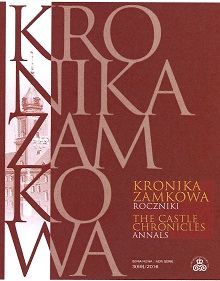Cztery projekty Akademii Sztuk Pięknych w Warszawie
Four designs for the Academy of Fine Arts in Warsaw
Author(s): Anita Chiron-MrozowskaSubject(s): Fine Arts / Performing Arts, History of Art
Published by: Arx Regia® Wydawnictwo Zamku Królewskiego w Warszawie – Muzeum
Keywords: academy of fine arts; Antoni Albertrandi; Marcello Bacciarelli; education; mercantilism; Michał Jerzy Wandalin Mniszech; August Fryderyk Moszczyński; Stanisław August; school of drawing
Summary/Abstract: On his ascension to the throne of Poland, Stanisław August not only wanted to transform the country, he also had artistic and cultural aspirations, including a desire to establish an academy of fine arts. Four designs were put forward during his reign. The first was the work of Marcello Bacciarelli and is dated to the end of 1766. In fact, this was not a plan for an academy in the strict sense, but a proposal for supplementing the core group of artists already working for Stanisław August. The second design, attributed to Michał Jerzy Wandalin Mniszech, dates from circa 1777 and emphasizes the national, noble and utilitarian qualities the academy should possess. The third design is definitely the largest and most precise; it is also dated circa 1777. It is signed with a monogram which reads ‘AM’ followed by three small Greek crosses. This design was attributed to August Moszyński, Director of the Royal Buildings from 1765 to 1772. Art historians have generally accepted this attribution, except for Zygmunt Król, who believes it was the work of Antoni Albertrandi, professor of painting, anatomy and an art theoretician. The last design was drawn up by Joseph Duhamel who, from 1777 to 1781, was Secretary of the Commission des Bâtiments. It consists of a single sheet of paper. This document is interesting because it outlines a version of the Malarnia (Painting Shop) and Sculptornia (Sculpture Shop), the composition of the staff and wages at a given time. It can be dated with accuracy: after October 1779 and before the month of November 1780. None of the designs for the academy of fine arts came to fruition. There must have been several reasons for this, one of these being that such an academy would have resulted in too restricted a framework and would have limited the king’s intervention in artistic matters.
Journal: Kronika Zamkowa. Roczniki
- Issue Year: 3/2016
- Issue No: 3
- Page Range: 203-240
- Page Count: 38
- Language: Polish

